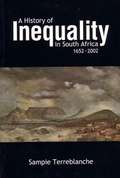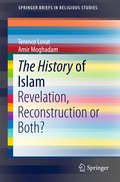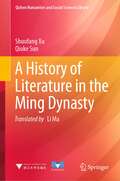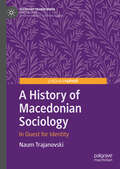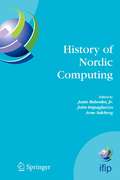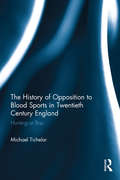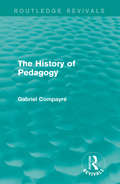- Table View
- List View
The History of Gay People in Alcoholics Anonymous: From the Beginning
by Audrey BordenThe History of Gay People in Alcoholics Anonymous documents and honors the ways thousands of LGBT people have carried Alcoholics Anonymous' message. This illuminating chronicle includes interviews and documents that detail the compelling history, recovery, and wisdom of gay people in AA. The book examines the challenges AA faced as the fellowship endeavored to become a more inclusive and cohesive community. The first-person accounts narrate the important work of influential gay and straight AA members that led key events in AA’s history. The author includes material on the steps and traditions of AA, and on becoming an ally to LGBT people on the road to recovery.Topics in The History of Gay People in Alcoholics Anonymous include: the gay origins of AA’s Third Tradition a comparison of treatments for alcoholism and homosexuality compelling portraits of sober gay life in the 1950s and 1960s the debate in AA over meetings for gay alcoholics interviews with members and co-founders of the first gay AA meetings the history of the first gay AA/Al-Anon conference interviews with pioneering gay addiction professionals the history of AA pamphlet “AA and the Gay/Lesbian Alcoholic” Alcoholics Together, and why a parallel AA organization for gay alcoholics formed in southern California strategies AA’s gay members developed to make their meetings simultaneously safe and public—and why some of them are still necessary today much more The History of Gay People in Alcoholics Anonymous is an enlightening book for members of the LGBT and heterosexual recovering community, alcoholism and addiction professionals, as well as physicians, counselors, psychiatrists, psychologists, social workers, clergy, historians, sociologists, educators, students, and anyone interested in learning more about AA or this aspect of the community’s history.
A History Of Inequality In South Africa 1652-2002 (PDF)
by Sampie Terreblanche Solomon TerreblancheThis work is an anlaysis of economic relations in South Africa. It analyses the work of numerous historians on inequality and exploitation in South Africa around a single theme: the systematic and progressive economic exploitation of indigenous people by settler groups. Second, the author argues that, despite South Africa's transition to democracy, its society is as unequal - if not more so - than before. He claims that in the early 1990s, parallel to the constitutional negotations, a series of informal negotations and interchanges took place behind the scenes during which the local corporate sector, backed by powerful international financial institutions, made a concerted effort to ""sell"" unfettered capitalism to ANC leaders. This attempt succeeded, resulting in the ANC replacing the RDP with GEAR. The situation of the vast majority of blacks has in fact worsened since the transition to democracy. For this reason, he considers that South Africa's transformation is incomplete. Sampie Terreblanche criticizes the corporate sector for its ruthless pursuit and protection of its own interests, to the detriment of broader South African society. He also criticizes the ""new black elite"" for its materialism and apparent indifference to the plight of the poor. In a final chapter, he argues that the current system of ""neo-liberal democratic capitalism"" is inappropriate to a developing country such as South Africa. He calls for a policy shift towards social democracy in which the state should play a more active role in alleviating poverty, redistributing wealth, and attending to social welfare.
The History of Islam: Revelation, Reconstruction or Both? (SpringerBriefs in Religious Studies)
by Terence Lovat Amir MoghadamThis book applies philosophical and critical textual scholarship to the traditional Islamic narrative in an attempt to distinguish between its historical and interpretive elements. It allows the narrative to be preserved with due respect for its significance and distinctiveness, but in a way that frees it from the ease with which it can slip into the hands of literalists and fundamentalists in order to serve a purpose which is at odds with its original spirit and intention. When radical Islamists use social media to try and convert young followers to a Jihadist cause, they refer often to the narrative about the Prophet, the original Islamic community (Ummah), and the holy book (Qur’an). The references usually imply that these are under threat by infidels, either non-Muslim Westerners or Muslims themselves who follow allegedly errant forms of Islam. The narrative itself is, however, never questioned; it is taken as merely factual with every word to be taken literally, including words that appear intolerant of difference and given to violence. As such, it can serve well the forms of fundamentalism that lie at the heart of radical Islamism and Jihadism. Because of a shortage of critical scholarship about Islam’s central narrative, the radical Islamist understanding of it differs too little from that of mainstream Muslims. Neither tends to take sufficient account of the context of the writing, its original purpose or the many interpretive elements that have been overlain. This makes it difficult for mainstream Islamic authorities to counter effectively the radical Islamist discourse or to distinguish moderate and liberal forms of religious practice from radical breakaway forms. In turn, this causes confusion among Muslims, who know the radical Islamists are in error but find it hard to say just why, and even greater confusion and angst among non-Muslims, for whom the allegation that all of Islam is inherently violent and to be feared is clearly being heard by an increasing number. This book sets out to address this problem by applying forms of scholarship that can preserve the best of the Islamic narrative while, at the same time, illustrating just how errant is the radical Islamist understanding of it.
A History of Italian Fertility During the Last Two Centuries (PDF)
by Massimo Livi BacciProfound changes have occurred in the demography and sociology of Italian fertility since Napoleonic times. Using the statistical system instituted in 1861 with national unification, Massimo Livi-Bacci provides a systematic and detailed analysis of fertility trends in Italy in the nineteenth and twentieth centuries. He brings to light the main features of the secular decline: its rapid occurrence in the northern and central areas; the widening urban-rural gap; the shaping of social and economic differences; and the late, slow downward trend in the South. Multivariate statistical analysis enables the author to measure the changing relationship between fertility and social or economic phenomena. Historical evidence illustrates the effect on fertility of mass emigration and Fascist policy as well as of social changes such as those in agrarian structure, mobility, and communications. An altered attitude toward procreation is evident in some parts of Italy in the early nineteenth century. The decline becomes apparent in certain northern and central regions in the 1870s and 1880s and it appears at the aggregate national level in the 1890s.Originally published in 1977.The Princeton Legacy Library uses the latest print-on-demand technology to again make available previously out-of-print books from the distinguished backlist of Princeton University Press. These editions preserve the original texts of these important books while presenting them in durable paperback and hardcover editions. The goal of the Princeton Legacy Library is to vastly increase access to the rich scholarly heritage found in the thousands of books published by Princeton University Press since its founding in 1905.
A History of Leisure: The British Experience since 1500
by Peter BorsayLeisure is a key aspect of modern living. How did our ancestors experience recreation in the past, and how does this relate to the present? To answer these questions, Peter Borsay examines the history of leisure in Britain over the past 500 years, analysing elements of both continuity and change. A History of Leisure- explores a range of pastimes, from festive culture and music to tourism and sport- emphasises a conceptual and critical approach, rather than a simple narrative history- covers a range of themes including economy, state, class, identities, place, space and time- treats the constituent parts of the British Isles as a fluid and dynamic amalgam of local and national cultures and polities.Authoritative and engaging, this text challenges conventional views on the history of leisure and suggests new approaches to the subject. Borsay draws upon the insights provided by a variety of disciplines alongside that of history - anthropology, the arts, geography and sociology - to offer an essential guide to this fascinating area of study.
A History of Leisure: The British Experience since 1500
by Peter BorsayLeisure is a key aspect of modern living. How did our ancestors experience recreation in the past, and how does this relate to the present? To answer these questions, Peter Borsay examines the history of leisure in Britain over the past 500 years, analysing elements of both continuity and change.A History of Leisure- Explores a range of pastimes, from festive culture and music to tourism and sport- Emphasises a conceptual and critical approach, rather than a simple narrative history- Covers a range of themes including economy, state, class, identities, place, space and time- Treats the constituent parts of the British Isles as a fluid and dynamic amalgam of local and national cultures and politiesAuthoritative and engaging, this text challenges conventional views on the history of leisure and suggests new approaches to the subject. Borsay draws upon the insights provided by a variety of disciplines alongside that of history - anthropology, the arts, geography and sociology - to offer an essential guide to this fascinating area of study.
A History of Literature in the Ming Dynasty (Qizhen Humanities and Social Sciences Library)
by Shuofang Xu Qiuke SunThis book explores poems, novels, legends, operas and other genres of writing from the Ming Dynasty. It is composed of two parts: the literary history; and comprehensive reference materials based on the compilation of several chronologies. By studying individual literary works, the book analyzes the basic laws of the development of literature during the Ming Dynasty, and explores the influences of people, time, and place on literature from a sociological perspective. In turn, it conducts a contrastive analysis of Chinese and Western literature, based on similar works from the same literary genre and their creative methods. The book also investigates the relationship between literary theory and literary creation practices, including those used at various poetry schools. In closing, it studies the unique aesthetic traits of related works. Sharing valuable insights and perspectives, the book can serve as a role model for future literary history studies. It offers a unique resource for literary researchers, reference guide for students and educators, and lively read for members of the general public.
A History of Macedonian Sociology: In Quest for Identity (Sociology Transformed)
by Naum TrajanovskiThis book is the first English-language monograph about the institutional development of sociology in (North) Macedonia. It maps and discusses the contexts, goals, and merits of the pioneering attempts for sociological research in the interwar period, early post-war educational and publishing politics, the institutionalization of sociology in socialist Macedonia in the course of the 1960s, its cross-national exchanges, as well as its major trajectories and debates up until the present days. Against the backgrounds of the political and intellectual histories of Yugoslav and post-Yugoslav Macedonia, it argues that the development of the sociological activities, themes, and arguments is entwined with the Macedonian nation- and state-building.
A History of Masculinity: From Patriarchy to Gender Justice
by Ivan Jablonka'Exhilarating . . . a work of scholarship, but also inspiration. . . Go and read Jablonka and change the world' Christina Patterson, Sunday Times'An unexpected bestseller in France. . . it has sparked conversations' ChallengesA highly acclaimed, bestselling work from one of France's preeminent historiansWhat does it mean to be a good man? To be a good father, or a good partner? A good brother, or a good friend? In this insightful analysis, social historian Ivan Jablonka offers a re-examination of the patriarchy and its impact on men. Ranging widely across cultures, from Mesopotamia to Confucianism to Christianity to the revolutions of the eighteenth century, Jablonka uncovers the origins of our patriarchal societies. He then offers an updated model of masculinity based on a theory of gender justice which aims for a redistribution of gender, just as social justice demands the redistribution of wealth. Arguing that it is high time for men to be as involved in gender justice as women, Jablonka shows that in order to build a more equal and respectful society, we must gain a deeper understanding of the structure of patriarchy - and reframe the conversation so that men define themselves by the rights of women. Widely acclaimed in France, this is an important work from a major thinker.
A History Of Modern Britain (PDF)
by Andrew MarrAndrew Marr's acclaimed Sunday Times number one bestseller, updated with an extensive new chapter. A History of Modern Britain by Andrew Marr confronts head-on the victory of shopping over politics. It tells the story of how the great political visions of New Jerusalem or a second Elizabethan Age, rival idealisms, came to be defeated by a culture of consumerism, celebrity and self-gratification. In each decade, political leaders think they know what they are doing, but find themselves confounded. Every time, the British people turn out to be stroppier and harder to herd than predicted. Throughout, Britain is a country on the edge - first of invasion, then of bankruptcy, then on the vulnerable front line of the Cold War and later in the forefront of the great opening up of capital and migration now reshaping the world. This history follows all the political and economic stories, but deals too with comedy, cars, the war against homosexuals, Sixties anarchists, oil-men and punks, Margaret Thatcher's wonderful good luck, political lies and the true heroes of British theatre.
History of Nordic Computing: IFIP WG9.7 First Working Conference on the History of Nordic Computing (HiNC1), June 16-18, 2003, Trondheim, Norway (IFIP Advances in Information and Communication Technology #174)
by Janis Bubenko John Impagliazzo Arne SoelvbergComputing in the Nordic countries started in late 1940s mainly as an engineering activity to build computing devices to perform mathematical calculations and assist mathematicians and engineers in scientific problem solving. The early computers of the Nordic countries emerged during the 1950s and had names like BARK, BESK, DASK, SMIL, SARA, ESKO, and NUSSE. Each of them became a nucleus in institutes and centres for mathematical computations programmed and used by highly qualified professionals. However, one should not forget the punched-card machine technology at this time that had existed for several decades. In addition, we have a Nordic name, namely Frederik Rosing Bull, contributing to the fundaments of punched card technology and forming the French company Bull. Commercial products such as FACIT EDB and SAAB D20-series computers in Sweden, the Danish GIER computer, the Nokia MIKKO computer in Finland, as well as the computers of Norsk Data in Norway followed the early computers. In many cases, however, companies and institutions did not further develop or exploit Nordic computing hardware, even though it exhibited technical advantages. Consequently, in the 1970s, US computers, primarily from IBM, flooded the Nordic market.
History of Nordic Computing 2: Second IFIP WG 9.7 Conference, HiNC 2, Turku, Finland, August 21-23, 2007, Revised Selected Papers (IFIP Advances in Information and Communication Technology #303)
by John Impagliazzo Timo Järvi Petri PajuThe First Conference on the History of Nordic Computing (HiNC1) was organized in Trondheim, in June 2003. The HiNC1 event focused on the early years of computing, that is the years from the 1940s through the 1960s, although it formally extended to year 1985. In the preface of the proceedings of HiNC1, Janis Bubenko, Jr. , John Impagliazzo, and Arne Sølvberg describe well the peculiarities of early Nordic c- puting [1]. While developing hardware was a necessity for the first professionals, quite soon the computer became an industrial product. Computer scientists, among others, grew increasingly interested in programming and application software. P- gress in these areas from the 1960s to the 1980s was experienced as astonishing. The developments during these decades were taken as the focus of HiNC2. During those decades computers arrived to every branch of large and medium-sized businesses and the users of the computer systems were no longer only computer s- cialists but also people with other main duties. Compared to the early years of comp- ing before 1960, where the number of computer projects and applications was small, capturing a holistic view of the history between the 1960s and the 1980s is conside- bly more difficult. The HiNC2 conference attempted to help in this endeavor.
History of Nordic Computing 3: Third IFIP WG 9.7 Conference, HiNC3, Stockholm, Sweden, October 18-20, 2010, Revised Selected Papers (IFIP Advances in Information and Communication Technology #350)
by John Impagliazzo Per Lundin Benkt WanglerThis book constitutes the refereed post-proceedings of the Third IFIP WG 9.7 Conference on the History of Nordic Computing, HiNC3, held in Stockholm, Sweden, in October 2010. The 50 revised full papers presented together with a keynote address and a panel discussion were carefully reviewed and selected from numerous submissions. The papers focus on the application and use of ICT and ways in which technical progress affected the conditions of the development and use of ICT systems in the Nordic countries covering a period from around 1970 until the beginning of the 1990s. They are organized in the following topical sections: computerizing public sector industries; computerizing management and financial industries; computerizing art, media, and schools; users and systems development; the making of a Nordic computing industry; Nordic networking; Nordic software development; Nordic research in software and systems development; teaching at Nordic universities; and new historiographical approaches and methodological reflections.
History of Nordic Computing 4: 4th IFIP WG 9.7 Conference, HiNC 4, Copenhagen, Denmark, August 13-15, 2014, Revised Selected Papers (IFIP Advances in Information and Communication Technology #447)
by Christian Gram Per Rasmussen Søren Duus ØstergaardThis book constitutes the refereed post-proceedings of the 4th IFIP WG 9.7 Conference on the History of Nordic Computing, HiNC 4, held in Copenhagen, Denmark, in August 2014. The 37 revised full papers were carefully reviewed and selected for inclusion in this volume. The papers focus on innovative ICT milestones that transformed the nordic societies and on the new ideas, systems and solutions that helped creating the welfare societies of today, in particular solutions and systems for public services, e.g., tax, social benefits, health care and education; solutions and systems for the infrastructure of the society, e.g., banking, insurance, telephones, transport and energy supply; and technologies and IT policies behind the major IT milestones, e.g., user centric innovation, programming techniques and IT ethics. They are organized in topical sections on IT policy, infrastructure, public services, private services, telesystems, health care, IT in banking, transport and IT technology.
The History of Opposition to Blood Sports in Twentieth Century England: Hunting at Bay
by Michael TichelarAn interdisciplinary social history, this book examines the major pressures and influences that brought about the remarkable growth of opposition to hunting in twentieth century England. With public opinion consistently deciding from the middle of the century onward that hunting mammals for sport was cruel and unacceptable, it would appear that the controversy over hunting has all but been decided, though hunting yet remains ‘at bay’. Based on a range of cultural, social, literary and political sources drawn from a variety of academic disciplines, including history, sociology, geography, psychology and anthropology, The History of Opposition to Blood Sports in Twentieth Century England accounts for the change in our relationship with animals that occurred in the course of the twentieth century, shedding light on the manner in which this resulted in the growth in opposition to hunting and other blood sports. With evidence comprising a mixture of primary and secondary historical sources, together with documentary films, opinion polls, Mass Observation records, political party archives, and the findings of sociologists, political scientists, anthropologists and geographers, this book will appeal to scholars and students across the social sciences and historians with an interest in human–animal relations.
The History of Opposition to Blood Sports in Twentieth Century England: Hunting at Bay
by Michael TichelarAn interdisciplinary social history, this book examines the major pressures and influences that brought about the remarkable growth of opposition to hunting in twentieth century England. With public opinion consistently deciding from the middle of the century onward that hunting mammals for sport was cruel and unacceptable, it would appear that the controversy over hunting has all but been decided, though hunting yet remains ‘at bay’. Based on a range of cultural, social, literary and political sources drawn from a variety of academic disciplines, including history, sociology, geography, psychology and anthropology, The History of Opposition to Blood Sports in Twentieth Century England accounts for the change in our relationship with animals that occurred in the course of the twentieth century, shedding light on the manner in which this resulted in the growth in opposition to hunting and other blood sports. With evidence comprising a mixture of primary and secondary historical sources, together with documentary films, opinion polls, Mass Observation records, political party archives, and the findings of sociologists, political scientists, anthropologists and geographers, this book will appeal to scholars and students across the social sciences and historians with an interest in human–animal relations.
The History of Pedagogy (Routledge Revivals)
by Gabriel CompayréPayne’s translation of Compayré’s The History of Pedagogy was initially published in 1886 due to a general lack of historical texts on education in the late nineteenth century. Compayré provides a thorough account of the doctrines and methods used by educators throughout history from educators of antiquity to the early nineteenth century. This text focusses on key thinkers and teachers such as Locke, Luther and Kant as well as considering the educational methods of the Greeks and the Romans. This title will be of interest to students of Education and Philosophy.
The History of Pedagogy (Routledge Revivals)
by Gabriel CompayréPayne’s translation of Compayré’s The History of Pedagogy was initially published in 1886 due to a general lack of historical texts on education in the late nineteenth century. Compayré provides a thorough account of the doctrines and methods used by educators throughout history from educators of antiquity to the early nineteenth century. This text focusses on key thinkers and teachers such as Locke, Luther and Kant as well as considering the educational methods of the Greeks and the Romans. This title will be of interest to students of Education and Philosophy.
History of Political Thought: A Thematic Introduction
by John MorrowThis innovative text provides a broad-ranging thematic introduction to the Western tradition of political thought. It reviews the contributions of a wide range of theorists to the key themes of the ends of politics, the location, exercise and justification for challenging or obeying political authority. The book concludes with an assessment of contemporary debates in political theory.
The History of Problem Gambling: Temperance, Substance Abuse, Medicine, and Metaphors
by Peter Ferentzy Nigel TurnerThis book documents the history of ideas about problem gambling and its link to addictive disorders. The book uses a combination of literature review and conceptual and linguistic analysis to explore the way ideas about problem gambling gave changed over time. It examines the religious, socio-cultural, and medical influences on the development of the concept of problem gambling as a disease, along with the ways in which such ideas were influenced by attitudes about substance abuse. The history of mental illness, notably as it pertains to themes such as loss of control over behavior, is also addressed. The book ends with a discussion of the current status and future prospects, with an eye to which ideas about problem gambling and addictions seem most promising and which should perhaps be left behind.
History of Psychology in Latin America: A Cultural Approach (Latin American Voices)
by Julio César Ossa Gonzalo Salas Hernan ScholtenThis book presents a cultural history of psychology that analyzes the diverse contexts in which psychological knowledge and practices have developed in Latin America. The book aims to contribute to the growing effort to develop a theoretical knowledge that complements the biographical perspective centered on the great figures, with a polycentric history that emphasizes the different cultural, social, economic and political phenomena that accompanied the emergence of psychology. The different chapters of this volume show the production of historians of psychology in Latin America who are part of the Ibero-American Network of Researchers in History of Psychology (RIPeHP, in the Portuguese acronym for "Rede Iberoamericana de Pesquisadores em História da Psicologia"). They present a significant sample of the research carried out in a field that has experienced a strong development in the region in the last decades. The volume is divided into two parts. The first presents comparative chapters that address cross-cutting issues in the different countries of the region. The second part analyzes particular aspects of the development of psychology in seven countries: Argentina, Brazil, Chile, Colombia, Mexico, Paraguay and Peru. Throughout these chapters the reader will find how psychology made its way through dictatorial governments, phenomena of violence and internal armed conflict, among others. Dimensions that include rigorous analysis ranging from ancestral practices to current geopolitical knowledge of the Latin American region. History of Psychology in Latin America - A Cultural Approach is an invaluable resource for historians of psychology, anywhere in the world, interested in a polycentric and critical approach. Since its content is part of the "cultural turn in psychology" it is also of interest to readers interested in the social and human sciences in general. Finally, the thoroughly international perspective provided through its chapters make the book a key resource for both undergraduate and graduate teaching and education on the past and current state of psychology.
A History of “Relevance” in Psychology (Palgrave Studies in the Theory and History of Psychology)
by Wahbie LongThis book represents the first attempt to historicise and theorise appeals for ‘relevance’ in psychology. It argues that the persistence of questions about the ‘relevance’ of psychology derives from the discipline’s terminal inability to define its subject matter, its reliance on a socially disinterested science to underwrite its knowledge claims, and its consequent failure to address itself to the needs of a rapidly changing world. The chapters go on to consider the ‘relevance’ debate within South African psychology, by critically analysing discourse of forty-five presidential, keynote and opening addresses delivered at annual national psychology congresses between 1950 and 2011, and observes how appeals for ‘relevance’ were advanced by reactionary, progressive and radical psychologists alike. The book presents, moreover, the provocative thesis that the revolutionary quest for ‘social relevance’ that began in the 1960s has been supplanted by an ethic of ‘market relevance’ that threatens to isolate the discipline still further from the anxieties of broader society. With powerful interest groups continuing to co-opt psychologists without relent, this is a development that only psychologists of conscience can arrest.
The History of Science and the New Humanism
by Michael NovakIn this classic work, the foremost historian of science in our time, George Sarton, sums up his reflections on the role of science and of the humanities in our culture. Voicing his opposition to the old-fashioned humanists on the one hand, and to the 'uneducated' men of science and technicians on the other, Sarton points out to the former that the humanities without scientific are essentially incomplete. He warns the latter that without history, without philosophy, without arts and letters, without a living religion, human life on this planet would cease to be worthwhile.After outlining his 'Faith of a Humanist' in the opening section, Sarton goes on to analyze 'The History of Science and the History of Civilization,' to discuss the progress of scientific thought since ancient times in 'East and West,' and to propose the solution for the educational and cultural crisis of our time in 'The New Humanism' and in 'The History of Science and the Problems of Today.' He concludes not only that science is a source of technological development that has changed the face of the earth and has convulsed our lives for good and evil, but that it nonetheless affords the best means of understanding the world, its people, and the multitude of their relationships. 'Science is the conscience of mankind.'Included in this edition is Robert M. Merton's address before the Sarton Centennial meeting of November 1984. It is a stunning tour de force in its own right, providing insights into Sarton, teaching and research at Harvard in the 1930s, and the personal interaction between Sarton the mentor, and Merton the pupil. The essay supplements May Sarton's earlier 'Informal Portrait of George Sarton.'
The History of Science and the New Humanism
by Michael NovakIn this classic work, the foremost historian of science in our time, George Sarton, sums up his reflections on the role of science and of the humanities in our culture. Voicing his opposition to the old-fashioned humanists on the one hand, and to the 'uneducated' men of science and technicians on the other, Sarton points out to the former that the humanities without scientific are essentially incomplete. He warns the latter that without history, without philosophy, without arts and letters, without a living religion, human life on this planet would cease to be worthwhile.After outlining his 'Faith of a Humanist' in the opening section, Sarton goes on to analyze 'The History of Science and the History of Civilization,' to discuss the progress of scientific thought since ancient times in 'East and West,' and to propose the solution for the educational and cultural crisis of our time in 'The New Humanism' and in 'The History of Science and the Problems of Today.' He concludes not only that science is a source of technological development that has changed the face of the earth and has convulsed our lives for good and evil, but that it nonetheless affords the best means of understanding the world, its people, and the multitude of their relationships. 'Science is the conscience of mankind.'Included in this edition is Robert M. Merton's address before the Sarton Centennial meeting of November 1984. It is a stunning tour de force in its own right, providing insights into Sarton, teaching and research at Harvard in the 1930s, and the personal interaction between Sarton the mentor, and Merton the pupil. The essay supplements May Sarton's earlier 'Informal Portrait of George Sarton.'

